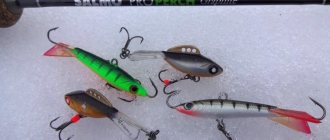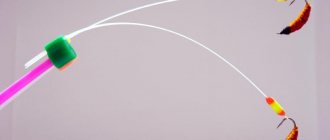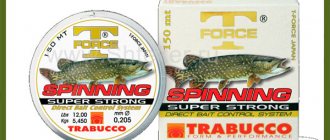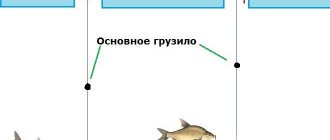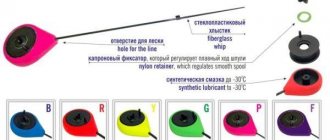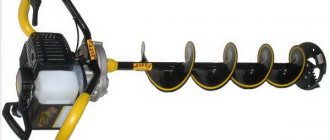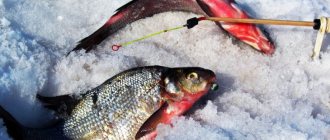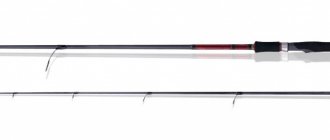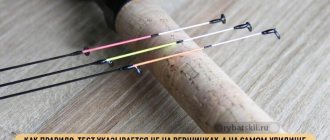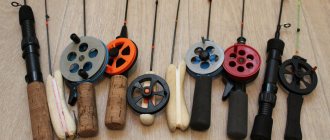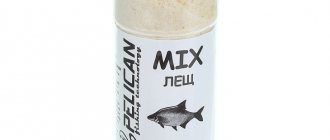What is more catchy: a spoon or a balancer?
The balancer and the spinner are completely different baits. Sometimes a spinner works better, sometimes a balancer works better. The main advantage of the balancer is that it collects and catches active fish very well. This is very evident and noticeable on the first ice.
Despite the fact that the balancer is equipped with three hooks, there are more empty bites on it than on the spinner.
Balancer for catching active fish
The balancer has a fairly active game. In order to fish in the dead of winter, when the fish are passive, it is necessary to use very short throws, while the balancer deviates very close from the axis of the hole and the height of the throw is in the range from 1 to 5 cm.
In the dead of winter, we use a method of guiding the balancer called “jigging,” when we don’t pull the balancer, but simply move it in place using the tip of a fishing rod.
At the beginning, on the first and last ice, we most often use a balancer, and in the dead of winter, when the fish are passive, we use a spoon.
How to choose balancers for catching zander, perch and pike?
For catching perch, balancers with a length of 3 to 7 cm are used, but the best results are brought by balancers with a length of 5 cm. It also comes down to the optimal length of the bait and its action. The “five” balancer plays better than the “three” and “four”, and the “seven” balancer plays just as well as the “five”, but in general it catches fish worse than the “five” balancer, so the most universal length of the balancer is the perch will be exactly 5 cm.
The pike perch balancer most often has a length from 5 to 9 cm, and the best results for pike perch are shown by balancers 7 and 9 cm long.
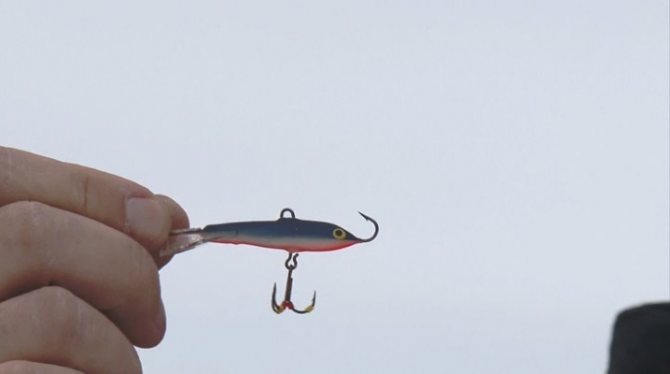
Balancer 5 cm for perch fishing
It is important to install a slightly larger tee on the pike perch balancer. This trick significantly reduces the number of empty bites from fanged robbers.
Pike bite on a balancer of any size, but undoubtedly baits with a length of 9 to 11 cm will be the most catchy.
Just as in the case of the zander balancer, on the pike balancer it is very useful to change the hook to a larger one.
Set of fishing rods
There can be as many rods equipped with balancers for perch in a fishing box as you like - at the discretion of the spinner. The most practical thing is three fishing rods of different constructions. They differ in the size of the balancers with which they are used. Accordingly, for heavy baits, prepare a more powerful tackle with a thick fishing line.
Main fishing rod

Of the three options offered, this one is average in terms of power and weight. Such a winter fishing rod for perch can be equipped with a 3-7 cm bait. A cheap Chinese lure with a built-in reel (or a 50-90 mm inertial reel) is also suitable as a fishing rod. However, preference should be given to high-quality carbon fiber, graphite or fiberglass fishing rods of medium hardness with a reel seat, vinyl or cork handle.
Among these store-bought winter trolling rods, you should choose options with a soft and sensitive whip - in order to clearly feel the play of light lures in your hand. But we don’t need to break through the bony mouth of a pike perch from great depths. This tackle will be used most often; most of the fishing time and the swinging of the hole is done with its help (provided there is a good bite on baits of medium weight and size).
Heavy tackle
A coarser winter fishing rod for perch is used with baits of 5-9 cm when biting on large baits, as well as for shaking the hole during periods of high striped activity - at the beginning and end of winter. Wide and strong vibrations of a large balancer attract perch from a distance of 10-20 meters (depending on the purity of the water and the current).
For example, upon arriving at a reservoir (except in the middle of nowhere, when it is immediately better to use the medium or light option), the fisherman needs to start exploring the holes with this particular gear. If the bite starts, just continue to use this fishing rod. In case of frequent gatherings, uncertain bites, we switch to a medium fishing rod.
For such a fishing rod, you need to use stiffer rods so that the heavy bait does not fall through the whip. The correct balance of the whip and the weight of the bait is when the rod bends barely noticeably under its weight, and does not bend much when tossing. For this, light versions of pike perch or pike rods, special winter perch rods or homemade rods (for example, from a feeder quiver tip) are used.
We suggest you read: Winter Fishing Fishing Methods
If on average tackle for perch it is more convenient to use a cheap plastic reel of 50-60 mm (or a reel in general), then a fairly powerful Chinese one, 90 mm, special for winter lures, or a 1000 spinning reel is more useful here. This is not for everybody. A large predator may covet a large bait, and you need to be prepared for this.
Lightweight
Winter perch ultralight helps out when the bite is bad and when the striped fish reacts only to ultra-light baits, up to 3 cm. This fishing rod is elegant and light, sensitive to the most gentle bite on the rise. For this tackle you need to use light lures with a reel. Lately, a homemade light fishing rod made from a regular winter balalaika, with a whip from a summer fishing rod 50-60 cm long attached instead of the original one, has become increasingly popular.
Such a tip costs a penny in a fishing store. The design is light and long, which gives a fairly large lever. That is why this tackle is so sensitive. The fishing line is passed from the balalaika inside the whip (to do this, during manufacture, a through hole must be drilled in the socket for the reel in the reel body).
How should the balancer hang on the fishing line? And what is the best way to connect it to the fishing line?
As a rule, balancers hang on a fishing line either horizontally or with the nose slightly raised upward. However, this is not a rule at all. Some models play very well and catch fish despite the fact that their nose is raised quite high. Other models are catchy even if their nose is slightly tilted down.
Branded balancers are tested and tested in special spacious deep containers with water, so tilting or lifting the spout does not affect their catchability at all. Some fishermen try to adjust the tilt of the balancer by hanging weights on the front hook, and thereby achieving a more horizontal position of the balancer on the line, but such manipulations can only worsen the performance of the branded balancers and, accordingly, their catchability.
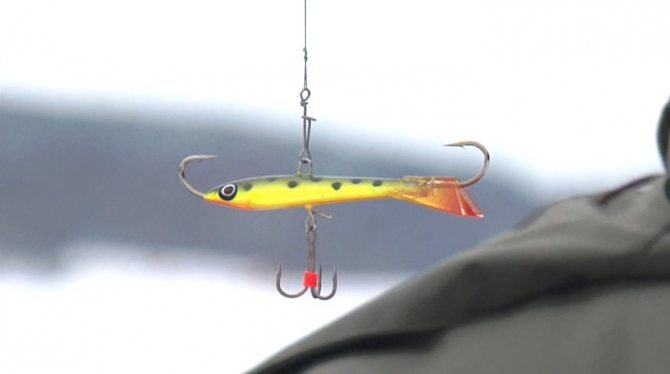
The nose of the balancer is slightly tilted down, but this does not affect bites
If the balancer plays well and catches fish, then there is absolutely no need to adjust it.
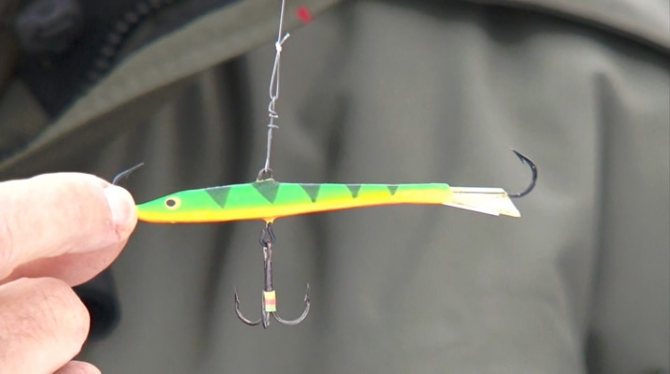
You should not change the tilt angles of branded balancers yourself.
How should the balancer be connected to the fishing line? The balancer must be connected to the fishing line either by means of a fastener or on a free loop. In no case should you tie the fishing line to the bait with a rigid knot, because during the fishing process the knot may move and the bait will hang on the fishing line in an inappropriate way. In this position the balancer cannot play.
Does the coloring of the balancers matter?
Yes, it has. All colors can be divided into three main groups:
- natural;
- fluorescent;
- glowing.
If we fish during the day in clear water, then it is most profitable to use natural colors. If we fish early in the morning or late in the evening and during the day in reservoirs with muddy water, then fluorescent colors are much more effective.
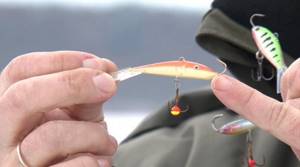
Fluorescent color of balancer
Glow in the dark colors always work when fishing in murky water, when fishing at dusk and even during the day they work amazingly. Moreover, a very interesting fact is that, for example, at dusk, pike perch are often afraid of luminous colors, but during the day they take them perfectly. Therefore, you should pay attention to fishing with luminous colors during the day, although it seems that they should be fished at night, but in fact they show excellent results during the day and in muddy and clear water.
The so-called balancers of hybrid coloring are worthy of attention; such baits have mostly natural colors, but their belly is painted with either fluorescent or luminous paint. Undoubtedly, this coloring is the most universal and works well in any conditions.
Do I need decorations on the balancer tee?
This question is very important. Previously, it was believed that the balancer must have some kind of decoration on the hanging tee. The logic here is simple: any decoration attracts the attention of the fish and the attack follows the hanging hook. However, as it turned out over time, the fish quite calmly bites even a balance bar with a simple hanging hook without any decorations.
Any voluminous decoration on the hook of the balancer reduces its movement away from the hole by about half. A balancer with a bare hook has an amplitude twice as large as the same balancer with an epoxy drop or some kind of voluminous decoration on the tee. Therefore, limiting the capabilities of the balancer is not always correct, because a wider game allows you to play with the balancer very softly and this must be used.

A piece of fluorescent cambric as an attack point
The drop limits the possibilities of play, so if it makes sense to decorate the hook of the balancer, then it should be done very carefully and trying not to increase the windage of the bait. An example of such decoration is a small piece of fluorescent cambric, which is located on the underside of the tee. Such a piece is also a point of attack and does not reduce the reach of the balancer during play. The balancer does not change the game intended by the manufacturer at all.
Choosing a balancer for pike.
For pike fishing, it is better to choose balancers that are not the smallest. A good size would be about 7 cm. In terms of coloring, it would be better to start with coloring like a perch or roach. When purchasing balancers in a store, you need to pay special attention to the size of the front and tail hooks. With equal dimensions of the balancer, the one with the larger hook is still better. If the balancer is already equipped with a tee, then it is better to change it to a larger one, but within reason, because this may negatively affect the performance of the bait.
How should you play a balancer?
When catching fish, you should know that you need to attract it to the hole with one game, and catch it with a completely different one.
To attract fish, a wide and sharp game is used with virtually no pauses. The height of the rises is somewhere in the range from 30 to 50 cm. Let us pay attention to the fact that the game when attracting fish should be sharp. With a smooth rise, the balancer simply rises up vertically and falls down very quickly, with virtually no deviation from the axis of the hole. When we make a sharp jerk, the balancer makes a leap far to the side, turns around and, on a stretched line, returns back to the axis of the hole. This is the game that is used to attract fish to the bait.
When the fish, after 3-6 strokes without pauses, approaches the bait, you need to switch to another game. Another game is that we make short and sharp throws with a height of 1 to 10 cm. In this case, we need to try to ensure that our bait deviates to the side very slightly. This is exactly the game used when fishing.
It is useful to make throws of such a height when the bait moves to the side at the moment of the jerk and returns to the axis of the hole with its tail, i.e., without a complete turn of 180 degrees. During such a game, it is very useful to raise the bait with the ledges up and then lower it in the same way with the ledges down.
Playing with bait on different horizons awakens excitement in the fish and creates the illusion of elusive prey.
The angler must constantly experiment and select the best game for the activity of the fish. The rule here is simple: the more active the fish, the more actively you need to play with the bait and, accordingly, vice versa - passive fish need to be caught with a very delicate, literally jig-like wiring of the balancer. Any variety in the game and change of leads provokes the fish to attack, so the more varied you play, guided by the activity of the fish, the higher the result will be.
How important is the color of the balancer's tail?
A balancer with a transparent tail makes the bait smaller than it actually is. If the tail of the balancer is made of red plastic, then the balancer looks larger.
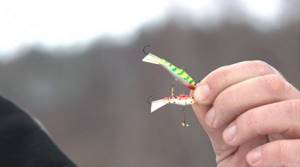
Balancers with transparent tail
When catching perch with a balancer, it is preferable to use balancers with a transparent tail. For catching pike perch, there is no particular difference with which tail the balancer is used - transparent or red. But when fishing for pike, the color of the tail is very important, because a balancer with a red tail seems even larger than it actually is. In addition, the color of the tail is very important when fishing for pike even if we know what type of fish the predator eats in this reservoir. If the main forage fish has red fins and tail, then undoubtedly a balancer with a red tail in this reservoir will be more catchy.
Why are the front and rear hooks on balance beams bent upward so much?
As a rule, most balancers are designed specifically for catching perch. As you know, the perch has a very delicate and soft mouth, and therefore when the balancer has hooks bent upward, the perch, when such a balancer is grabbed, very often hooks itself, you don’t even need to pull the fishing line.
Unfortunately, when we are going to hunt for pike and pike perch, this happens much less often and in order to catch the fish well, you need, as they say, to tug the bait decently.
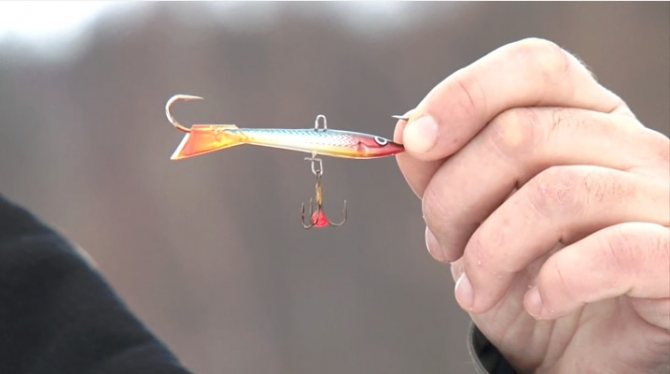
Correct balancer with a powerful hook for pike
It must be said that even large modern balancers have rather small front and rear hooks, so this makes hooking large predators such as pike and pike perch worse. Therefore, if we are going to choose a balancer for perch, it is very easy to do, but if we want to choose the ideal balancer for catching pike perch and pike, then we will have to think and search a little.
Below are lures that have the correct hooks for catching large predatory fish. These hooks are powerful, made of thick wire, sharp, and on some of these balancers the tip of the hook is directed strictly in the direction of the loop to which the fishing line is attached. When the sting is directed towards the loop at the moment of hooking, the load is transferred directly to the sting, without deflection, and if our hook has a slightly bent upward sting, then the load is reduced and the hook has less penetrating ability. This hook arrangement is ideal for catching hard-mouthed predators such as pike and pike perch.
Catch balancers
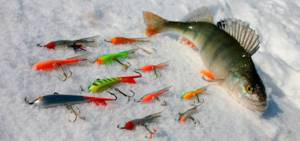
Each fisherman decides for himself whether to use a purchased balancer or make one himself. Which one will be the best and catchiest? It is necessary that with the help of a balancer you can play an interesting game, especially to attract such a predator as a pike.
All balancers are divided into three types:
- With plastic tail and stabilizer;
- Silicone baits;
- With plumage at the end in the form of an edge.
Lures with plastic plumage are the most popular and are considered the most catchy. This species is considered a classic and should be in every fisherman's arsenal.
If the hunt is carried out in shallow water near reed thickets, then the best ones will be balancers, the length of which is 4-5 cm with soft plumage. With its help, you can play smoothly, imitating the movements of the fry. If you need to catch pike, then the color of the bait should resemble the color of the perch.
At depth when hunting for a predator, it is better to buy a long balance beam, about 8-10 cm. It is better to take a model with a soldered hook so that the prey does not fall off. The color can be red, gold or silver.
You should choose a balancer taking into account the fish that is found in the reservoir, and select the color of the bait and even the size to match its color. Perch color works well. You can also take bright baits of unnatural colors, such as green, red or yellow.
The size is also selected taking into account the depth at the fishing site and the intended catch. For fishing at great depths, it is better to take heavy and long balance beams, which sink more easily.
If the day is cloudy and the water is dark, then you should choose bright colors so that the fish can notice them even at a fairly large depth. It is also important to take a bait with good mobility in order to attract the attention of even the least active fish.
What fishing line is needed when fishing with a balance beam?
For fishing in standing waters, it is best to use monofilament. The diameter of the monofilament line is selected according to the weight of the balancer, its resistance during the swing and the elasticity of the whip. As a rule, you should not be afraid of thick fishing lines, a thick fishing line has less elongation than a thinner one, and if we put a thin fishing line, for example, 0.2-0.22 mm, on a heavy balancer, then during the swing the fishing line will stretch and the balancer will rise vertically up and fall sharply down, i.e. we won’t be able to get the game we need.
With a thick fishing line, such a game is absolutely easy to make. In addition, a thick fishing line makes the movements of the balancer smooth, and this undoubtedly affects the effectiveness of fishing, because the balancer, which smoothly returns after a swing back, awakens the predator's hunting passion and it is at this moment that it attacks the balancer.
Based on these considerations, for a balancer 3-4 cm long, it is better to use a fishing line with a diameter of 0.14 to 0.2 mm. If we use balancers 5 cm long, then most often we use fishing line from 0.2 to 0.24 mm. For 7 cm baits, fishing line with diameters from 0.28 to 0.3 mm is very suitable. For the largest balancers, you will need a fishing line with a diameter of 0.33 to 0.4 mm.
If you have to fish on rivers or reservoirs with fairly strong currents, then undoubtedly the use of braid is more than justified. Braid is good for everyone:
- she perfectly conveys the bite;
- Lures work great on it.
It has only one drawback - it is fishing for fish, especially large fish, because it is easy to cut your hands on the braid when fishing. But, nevertheless, you have to put up with this, because in current conditions there is nothing better than using braid.
Braid is used with a diameter of 0.12 to 0.2 mm.
What kind of fishing rod is needed for fishing with balance beams?
As in a spinning rod, the rigidity of the fishing rod must clearly correspond to the weight of the bait. Ideally, you need to select a fishing rod that does not bend under the weight of the bait. This gives us the opportunity to play the bait very sharply, briefly, and at the moment when our bait moves to the side and comes back, we will not have parasitic bouncing as with a softer fishing rod. Parasitic bouncing always worsens performance because it slightly disrupts the game and alerts the fish.
After swinging, the fishing rod should always stop sharply and not twitch. In addition, when we hold the fishing rod, we do not hold it rigidly, but a little relaxed, and therefore at the moment when our bait goes down, we slightly soften the blow on the tip of the fishing rod and the bait lands very softly on the tip of the fishing rod. This is also very important. If you hold the rod tightly, the tip of the rod will bounce.
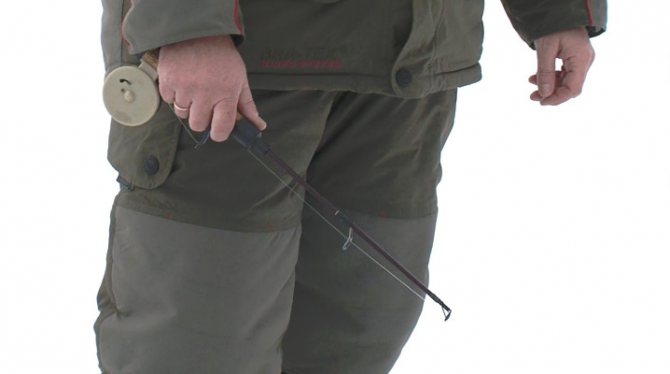
Fishing rod for fishing with balance beams
During the fishing process, we use our finger, this increases sensitivity and allows us to clearly record everything that happens to the bait. We can perfectly feel any bites, even the most careful ones, with our fingers, and since the fishing line is also matched to the weight of the balancer, this also gives good sensitivity to the finger when biting and makes it possible to make a timely hook.
The optimal length of a fishing rod for fishing with balance beams should be in the range from 40 to 50 cm. With such a fishing rod you can fish both standing and sitting.
Important Details
When fishing in clear, clear water, it is better to use fluorocarbon. Some predators in winter may not take the bait if they sense a catch. Fluorocarbon has less elongation, so its use when catching large pike in shallow water can end in a cliff (if the angler is inept). On the contrary, a fishing line that is too stretchy, and even at a decent depth, with a large weight of the balancer, can disrupt the performance of the bait.
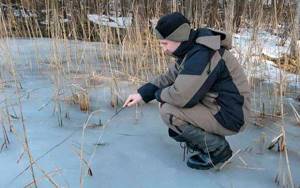
The choice of fishing line for fishing with a balancer in winter is not limited to selecting the correct diameter. It is important to consider the following characteristics:
- Strength;
- Extensibility;
- Invisibility;
- Tendency to freeze;
- Softness (lack of memory) at low temperatures.
Which line for the balancer is better, each angler decides for himself using a simple search method. Together with the fishing line, the tackle should sense the play of the bait. There are no special solutions for winter fishing with a balancer; you need to experiment, choosing the best option. Monofilament should be durable, preferably invisible in water. Frozen ice should be cleaned off well without damaging the surface.
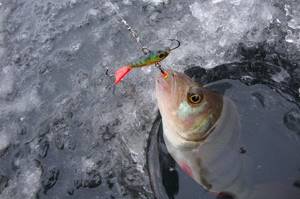
It is better to use soft types of fishing line, with no memory, but at the same time with average elongation. Excessive extensibility, as already mentioned above, is harmful. Soft winter monofilament with low memory, after being removed from the reel or reel, completely straightens under the weight of the bait, without losing such properties even in severe frost.
At depth it is better to use fluorocarbon, as it has less elongation compared to monofilament. At such depths, heavy balancers are used; excessive springiness of the monofilament will negatively affect the correct performance of the bait. When catching large fish in shallow water, a regular winter monofilament line works better. It stretches better and absorbs the jerks of the fish.
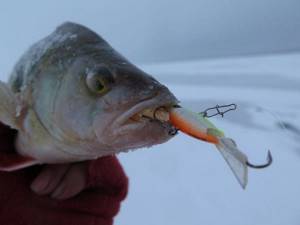
On the other hand, depth and insufficiently clean water allow the use of thicker equipment (but not to the detriment of the action of the bait). But some ichthyologists claim that the fish “sees” the equipment in the water not with its eyes, but with its lateral line. If this is so, then the “invisibility” of thick fluorocarbon does not make sense - the fish will still detect it with their radar.
These questions will come into place only after the fisherman personally uses the gear on the pond. Depending on the conditions and certain nuances, each fisherman develops his own methods of rigging fishing rods and fishing tactics. The article provides only a theoretical basis from which to build on in practice.
Subscribe to the channel:
My YouTube channel RYBAFAN on fishing:
We're OK
Do you need a nod on a fishing rod for a balancer?
There is an opinion that a nod is not needed for fishing with balance beams. The fact is that most balancers are quite heavy, they pull the line well, and in this case the nod has absolutely no effect on the performance of the balancer and the sensitivity of the tackle as a whole. If the stretchability of the fishing line is well matched to the weight of the bait, then it is very difficult not to notice the bite, and if we catch what is called a finger, then it is not possible at all.
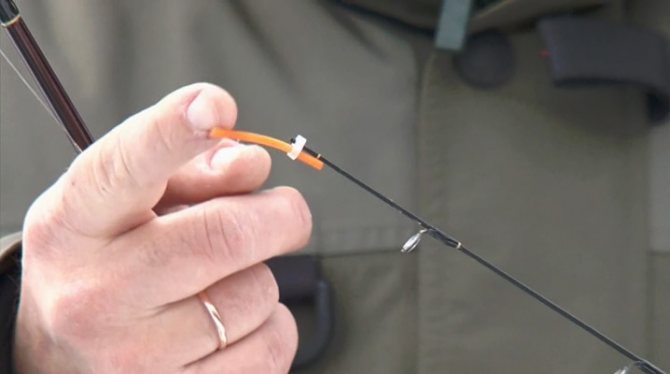
Miniature nod for fishing with small balancers
Using a nod is possible only if we use the smallest balancers 3-4 cm long. It is with such balancers that a miniature nod is often used and allows you to notice careful bites and the passage of fish near the bait. In principle, a nod is needed only when fishing with a spinner, but not in all cases, because a nod revives the play of the spinner, and to revive the play of the balancer, on the contrary, a more rigid connection is needed between the tip of the rod and the bait. In this case, the bait can be controlled more efficiently.
What does the tackle consist of?
To realize the full potential of the catchability of the bait, it is necessary to properly equip the tackle. To do this, it is important to choose the right rod, reel, fishing line, and nod.
We recommend reading: Carolina spinning equipment
Rod
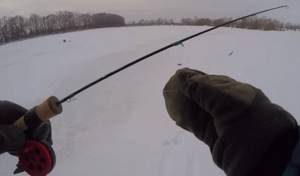
A rod for fishing with a balance beam in winter is selected taking into account the object being fished and the weight of the bait used:
- For heavy baits and large fish, use carbon-fiber rods 60-70 cm long with a sensitive whip equipped with 3-5 guide rings. The handle of this rod is made of cork and has a simple screw reel seat.
- For small fish and medium-sized baits, simple plastic rods 30-40 cm long with a built-in drum reel are used
The universal fishing rod for the balancer is approximately 50 cm long.
Coil
The choice of reel depends on the fishing rod used:
- For carbon fiber rods, simple metal wire inertial reels with a diameter of 60-70 mm with a key brake are used;
- Simple fishing rods have built-in open drum reels with a diameter of 50-60 mm.
Inertialess reels for ice fishing on a balancer are rarely used. This is explained by their heavy weight and unreliable operation in severe frosts.
fishing line
A 20-meter supply of simple monofilament fishing line is wound onto the tackle reel. The optimal thickness of the fishing line is 0.18-0.22mm. The use of thinner fishing line makes the tackle vulnerable when fishing for large fish. A fishing line that is too thick makes the equipment rough and reduces its sensitivity.
Monofilament fishing line for balancer is more preferable than summer braided cords. The latter becomes too hard at low temperatures and freezes heavily.
On a note! Sports fishermen use high-quality braided fishing lines with a cross-section of 0.1-0.12 mm in balance fishing, always applying a special lubricant to them. This allows you to eliminate freezing and roughening of the cord, and increase the sensitivity of the gear.
To disguise the equipment and absorb the jerks of the fish when playing, tie a meter-long piece of monofilament 0.2 mm thick to the braid. Similar to a feeder shock leader, this installation allows you to catch very large fish from great depths.
Nod
The use of a nod in balancing gear depends on the weight of the bait and the type of fishing rod:
- When fishing with perch balancers weighing up to 5 grams, the use of a nod on all types of rods is mandatory. For such baits, a brightly colored silicone balancing nod with a length of 70 mm and a dough of 5 g is used.
- For fishing with lead fish weighing 6-10 grams using simple plastic rods, use nods made of a flat or twisted spring 8-10 cm long with dough up to 15 g;
- In rods with thin whips, used for catching pike and pike perch with heavy balancers, no nod is used. The graphite whip of such fishing rods transfers all suspicious blows, touches of the bottom with bait, and hooks well into the hand.
Recommended reading: How to catch carp with a float rod
Note! The use of nods is mandatory for novice anglers. This part of the equipment will allow a beginner to “feel” the bottom when lowering the bait, see the bite, and learn how to perform the retrieve correctly.
Leash
The leash in the balancing gear has a negative impact on the performance of the bait and the number of bites. Its use is adjusted taking into account the conditions and fishing objects:
- For catching perch and pike-perch, a leash in a balancing tackle is not used;
- When fishing for pike, thin and short models made of tungsten and copper string with a total length of no more than 7-10 cm are tied to the main line. Ultra-thin titanium leashes are comfortable and durable.
On a note. In order to tie the balancer to the main line without using a leash, use a simple double loop.
When fishing with balance gear in unfamiliar bodies of water, the use of leashes at first is mandatory.
Why does the balancer need three hooks?
The balancer is equipped with three hooks at once and it may seem that no matter from which side the fish attacks the bait, it will always be hooked, but not everything is so simple.
The fact is that the biggest problem with any balancer is the front hook. This hook serves as a kind of lever and if, for example, a fish sits on the lower hanging tee, and we bring the fish to the hole, then the balancer very often with the front hook clings to the lower edge of the hole, as a result the fish has a lever, and it most often falls off bait hooks. Therefore, to reduce the problem of the front hook catching on the lower part of the hole when fishing with balancers, you always have to use a hole with a larger diameter than when fishing with winter lures. You definitely have to put up with this.

Balancer without front hook
If, for example, we can catch a pike perch weighing up to 1.5 kg quite calmly in a hole with a diameter of 100 mm, then with a balance beam 5-7 cm long in such a hole it is already quite difficult to catch, there will be a lot of catches, but in a hole with a diameter of 130 mm it is already normal.
The most radical way to solve the problem of the balancer hooks catching on the lower edge of the hole will be to bite off the front hook of the balancer. This is done deliberately, and to compensate for the lack of a front hook we increase the size of the tee. As a result, we never have the hook get caught on the ice, and the number of fish escapes is reduced.
When you bite off the back hook, it becomes possible to quickly catch schooling perch using a balance beam. Typically, such changes can only be made with a vertical spoon, but if you modernize the balancer in this way, you can catch schooling perch quite effectively with the balancer.
Equipment for a winter fishing rod for perch with a balancer
Having decided on the types of fishing tools that use balancers, you can move on to one of the most important stages of preparing for fishing. Proper equipment of a winter fishing rod is the key to successful fishing.
The equipment of fishing equipment must be approached competently, taking into account the behavioral characteristics of the perch.
Leash
Many novice fishermen make serious mistakes already at the stage of preparing a fishing rod. One of these mistakes is installing a leash, which is quite logical for pike fishing. However, in the case of perch, the use of this equipment can negate all the efforts of the fisherman.

It is not recommended to use a leash when fishing for perch.
The leash greatly impairs the game and creates unnecessary vibrations in the water, which scare away a cautious predator.
Coil
The decision to use a coil is entirely individual. This element of equipment significantly makes the rod heavier, which is essential for this type of fishing, where sometimes you have to play continuously for several hours in a row.
At the same time, a quality reel:
- makes it possible to fish at great depths, where you need a solid supply of fishing line for lowering and subsequent play of the bait;
- prevents rod breakage;
- ensures smooth, straight line movement, which is very important when fishing for large fish;
- simplifies the transportation of fishing equipment.
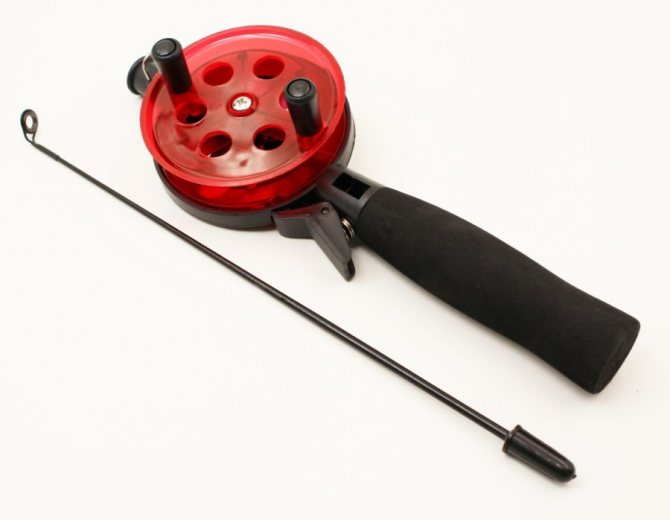
Condor winter fishing rod with reel
The choice of reel should be approached wisely. Cheap plastic options break easily on the first fishing trip, especially during severe frosts. In addition, they do not provide a smooth ride, thus negating the main advantage of using reels.
Nods
Many fishermen question the advisability of using a nod. Proponents of noddle fishing believe that a sensitive fishing rod is sufficient for effective fishing. If the tackle is correctly selected in accordance with the weight of the load, bites are already given to your hands.
On the other hand, many fishermen actively use various types of nods (lavsan, silicone tubes, clock springs). In this case, the nod is not used for play; its main purpose is to track bites.
This equipment is necessary when the perch shows little activity. In this case, the predator takes the bait very carefully, without trying to swallow it. Such weak bites are difficult to feel through a fishing rod.
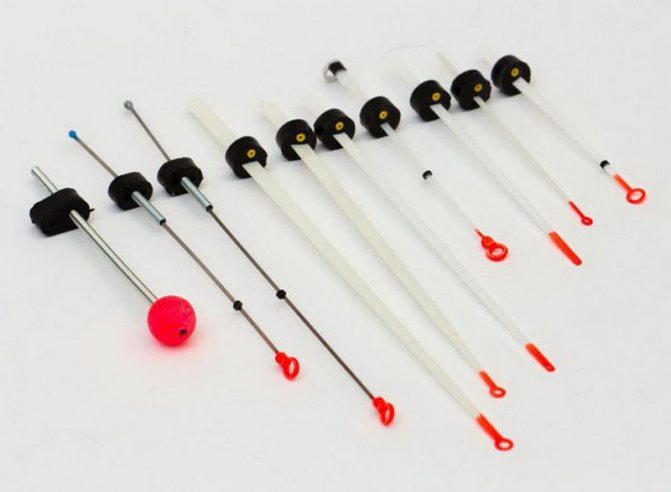
A set of nods for a winter fishing rod
For these situations, you need a nod that will not raise the balancer. It should be soft, bend almost completely from the weight of the load and simply hang down, unbending only when bitten.
fishing line
When fishing with balance beams, it is very important to use the correct line. The wrong choice can lead to a host of problems, including:
- low bites due to incorrectly selected thickness;
- entanglement;
- breaks due to accidental snagging.
To avoid trouble, when choosing a fishing line, you must first take into account the size of the bait installed and the type of fishing rod. Depending on the weight of the gear, it is advisable to adhere to the following intervals:
- for light loads, a thickness of 0.13 to 0.16 mm is suitable;
- for average - from 0.16 to 0.20;
- for heavy - from 0.20 to 0.25 mm.
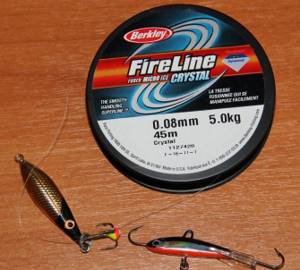
However, it is worth remembering that using a fishing rod with a fishing line diameter of up to 0.16 mm carries the risk of breaking when fishing for large fish and getting caught on foreign objects. In addition, the thickness stated on the packaging does not always correspond to the actual cross-section.
